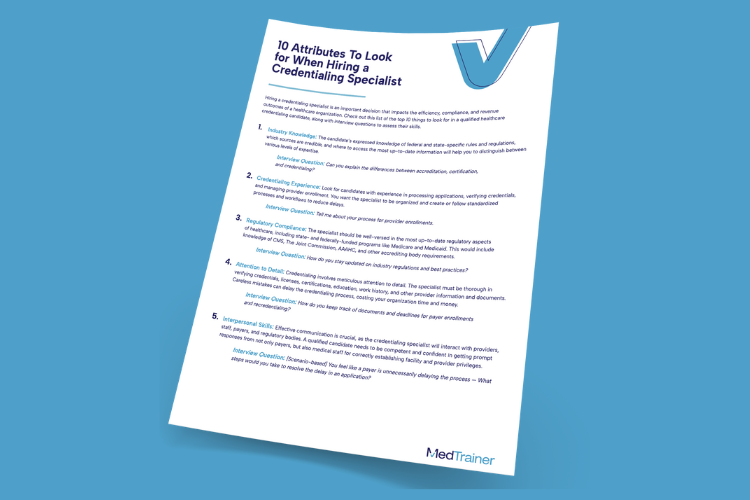Provider privileges and credentialing are two processes used when onboarding a healthcare provider to an organization and facility. Many assume they’re the same, but these processes differ entirely. To help you better understand, we’ll review each process and the key differences below and discuss why both are essential.
What is Provider Credentialing?
Provider credentialing is how an organization verifies a healthcare provider’s qualifications and background to deliver medical services. Credentialing specialists employed at the healthcare organization or through a contracted credentialing service typically complete this process.
The specialist authenticates the provider’s education, work history, licenses, and other information during provider credentialing. The specialist contacts other parties and primary sources to verify the provider’s information – prior employers, references, and educational institutions.
Additionally, the credentialing specialist may request a record of any pending and past medical malpractice cases and disciplinary actions from the appropriate authority. Upon completion and approval, the provider can begin billing for medical services.
Look for these 10 attributes in a credentialing specialist.
What are Provider Privileges?
Privileging involves verifying a healthcare provider’s specific skills and competency to perform patient care and health services within their scope. As the Centers for Medicare and Medicaid Services outlines, privileging isn’t required for every healthcare provider but is a requirement for those conducting medical services within a hospital or ambulatory surgery center (ASC). After completing the privileging and peer review process, the healthcare organization grants the provider privileges to render patient care services at the approved facilities.
There are three types of privileges that hospitals or healthcare facilities can grant:
- Admitting: When a provider is permitted to and frequently registers patients to the hospital, it’s called admitting privileges.
- Courtesy: This is when a hospital occasionally allows a provider to admit and treat a patient.
- Surgical: Surgical privileges are specifically for physicians and surgeons who can perform inpatient and outpatient surgeries.
Central Differences Between Privileges and Credentialing
Provider privileges and credentialing are similar in some ways, but some key differences exist. First, provider credentialing is always a prerequisite for privileging. All healthcare providers must become credentialed before providing patient care at any healthcare facility.
However, not all providers need hospital privileges. For example, a physician strictly practicing at a family medicine office wouldn’t need privileges since they are providing outpatient services and not admitting patients to the hospital. However, physicians must be credentialed to provide and bill for services. Alternatively, a provider who frequently admits patients to the hospital requires privileges and credentialing. Examples are surgeons, hospitalists, and intensivists. The table below details additional differences:
|
Privileges |
Credentialing |
|
| Process Outcome | Verifies provider’s background and experience to conduct specific services within their clinical specialty | Confirms provider’s eligibility and qualifications to bill for medical services |
| Who Can Complete the Approval Process | Hospitals or healthcare facilities | Healthcare organizations or third-party credentialing services |
| Setting | Inpatient services or outpatient surgical facilities in some cases (i.e., surgeons) | Inpatient, outpatient, and other ancillary services |
| Required Documents | Credentialing completion and specifics on training, like residency program completion and/or a required amount of procedures with positive outcomes | Background and qualification documents such as licenses, education, and work history |
| Timeline | Several months and is after the credentialing process | Several weeks to months |
| Examples of providers required to complete the process | Surgeons, hospitalists, inpatient physicians, and other physicians with admitting or courtesy privileges | Physicians, nurse practitioners, physician assistants, physical therapists, and other healthcare providers |
Why Privileges and Credentialing are Essential
Provider privileging and credentialing are vital to verifying a healthcare provider’s professional qualifications and standards of practice. Here are some reasons why it’s important:
- Authorizing a provider to practice: The credentialing process allows a provider to provide medical services legally. Privileging permits a healthcare provider to conduct services within their scope of practice at a specific healthcare facility. Both are essential before providing medical services within any hospital or inpatient facility.
- Meets compliance standards: Both processes verify a provider has met compliance standards. Whether it’s government regulation or healthcare facility requirements is a matter. Maintaining compliance helps protect against fraud, waste, and abuse.
- Upholds quality: Credentialing verifies a provider’s qualifications and background, which confirms a provider’s competency. The privileging process reviews a provider’s scope of practice, quality standards, and patient care outcomes. Therefore, both demonstrate a provider’s ability to uphold high-quality, safe patient care.
- Permits insurance reimbursement: All insurance companies require provider credentialing to receive reimbursement for services rendered. Additionally, some insurers require that a provider has privileges within a healthcare facility. Showing proof of provider privileges and credentialing is how a healthcare facility and provider get paid.
Privileging and credentialing involve a comprehensive review and verification of a provider’s background and qualifications. Expedite your healthcare organization’s credentialing process by using MedTrainer.
Watch this on-demand webinar for insights to improve your internal credentialing.

